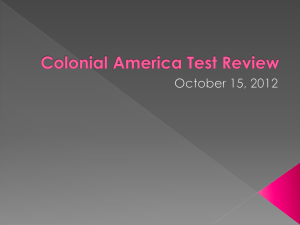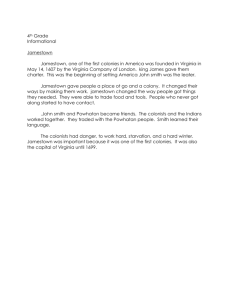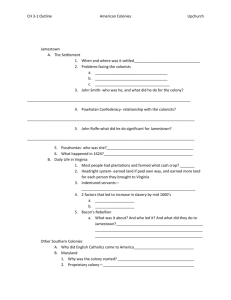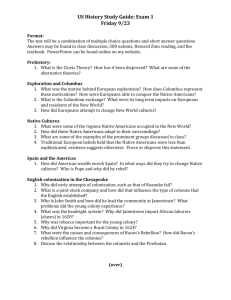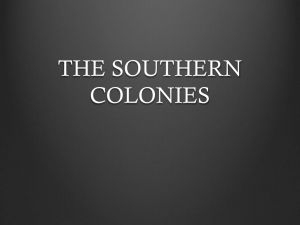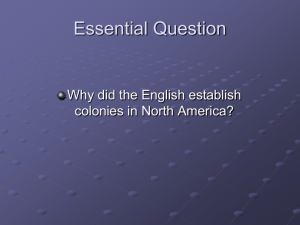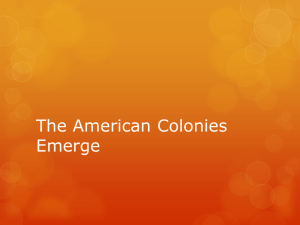2 European Colonization
advertisement
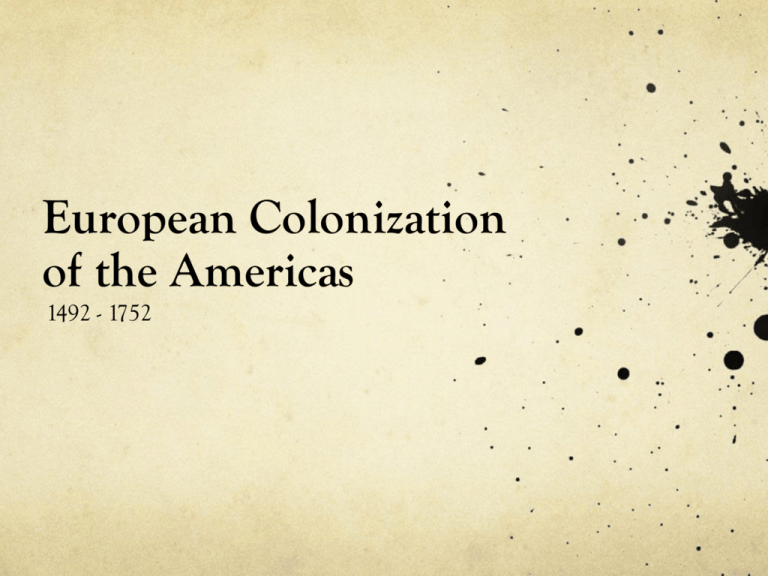
European Colonization of the Americas 1492 - 1752 Spanish Explorers & Colonies Building a Spanish Empire (see map p. 30) Conquistadors come to the New World for “God, gold and glory.” Juan Ponce de Leon – Sought the Fountain of Youth. Claimed Florida for Spain Vasco Nunez de Balboa – explores the isthmus of Panama. First European to see the Pacific from America Ferdinand Magellan – died along the way but…his ship made it around the world (first known to do so) Hernan Cortes – Conquers the Aztecs Francisco Pizarro – fights to conquer the Incas Spanish Colonies Unlike other Europeans, the Spanish incorporate native peoples into their colonies. mostly forced labor Some intermarriage Spanish push north in search of gold, defensive positions and trade routes. Missionaries – do most of the actual work of colonization, but are resisted by native peoples Pueblo Revolt 1680 National Geographic: Guns, Germs & Steel The Jamestown Colony Early English Explorers Henry Hudson: Thought the Hudson River was the “Northwest Passage.” But it wasn’t. Still a nice river though. Sir Francis Drake: “Sea Dog.” First English captain to sail around the world. England wants American colonies Base for privateers Looking for a Northwest Passage to the Indies Want new markets England’s too crowded! Jamestown, Virginia Jamestown 1607: After the Roanoke mystery / disaster, English investors get a charter to form a joint-stock company (Virginia Company) that will finance a stronger colony at Jamestown, Virginia. Hard Times Settlers not used to colonial labor Swamps = mosquitoes = disease = death Weak leadership until John Smith takes charge, but he gets hurt and goes home. The Starving Time (see p. 39) Breaking News: Things got REALLY BAD at Jamestown Jamestown Governing the Colony Virginia Company fails so King James I takes over and makes Jamestown / Virginia a royal colony – governor appointed by the king. Virginia has its own legislature made up of colonists (House of Burgesses). First instance of limited self-government in the English colonies. Native Americans fight back as the colonists push out into their territory. Jamestown Tobacco to the rescue! Colonists send some of this native plant back to England and $$$ begins to flow. Tobacco plantations begin to grow Brits are promised 50 acres if they go to Virginia Great deal because England is overcrowded and unemployment is high Indentured servants – poor folks who couldn’t afford to sail for the New World would agree to work off the passage fare (7 years!) if a rich plantation owner paid. Bacon’s Rebellion Nathaniel Bacon: Tougher than he looks. Bacon’s Rebellion: poor colonists got tired of a government that doesn’t care about them. Bacon went to fight the natives for more land, but turned around and burned Jamestown instead. He controlled Virginia until he got sick and died a few months later. New England Colonies The French in North America Verrazano (an Italian) came through NY Harbor French settle along rivers and focus on fur trade with Native Americans, which leads to Iroquois League Plymouth Colony Puritans flee England for religious freedom Mayflower Compact – early self-government In search of a “Purer Society for God” religious intolerance leads to abuse: Salem Witch Trials. (p. 45) Puritan ethic New England Colonies MA, RI, CT, NH Geography: Good harbors, cold winters, rocky soil, short growing season Society: Generally established to escape religious persecution (English Puritans). Highly literate society, Protestant work ethic Economy: diverse - trade, shipbuilding, lumber, fishing Town Meetings – early self-government Middle Colonies NY, NJ, PA, DE 1644 - New Amsterdam becomes New York (NYC!) Geography: Less severe winters, fertile soil, good harbors Society: very diverse in terms of nationalities and religions Economy: some cash crops (wheat, corn), some trade Southern Colonies VA, MD, NC, SC, GA Geography: Long growing season, fertile soil Society: English & African slaves Economy: Large scale farming plantations (tobacco, rice, indigo) Plantations were largely self-sufficient; least populated region Slavery in the Colonies Slaves were held throughout the colonies, but they became essential in the Southern Colonies Slavery becomes permanent (not indentured servitude) By 1700, slavery becomes law and race-based. Slave resistance On slave ships – revolts or suicide In the colonies – escape, resistance, rebellion Primary Source – Aboard a Slave Ship, Olaudah Equiano Growth of the American Colonies 1689 - 1754 Mercantilism: $ = Power Balance of Trade: Economics Concept (p. 60) Colonies send raw goods to England / buy English made goods Salutary Neglect: England essentially left the colonies to their own devises, as long as the trade balance was in Her favor.

